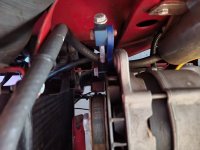AUSMHLY
Yoda
Offline
Hello,
I'm replacing the Lucas C42 generator with a WOSP LMDC42 alternator, Dynator.
The pulley on the WOSP has a smaller diameter than the Lucas.
1) Does the diameter make a difference? Should I swap or ok to leave the smaller WOSP?
2) If I should swap, how do I remove remove the nuts.
The Lucas has one nut.
The WOSP seems to have 2 nuts. A smaller one in the center of the larger one. Not sure if the small center nut needs to be removed or why it's there. How do I remove one or both to get the pulley off?
Thank you in advance.


I'm replacing the Lucas C42 generator with a WOSP LMDC42 alternator, Dynator.
The pulley on the WOSP has a smaller diameter than the Lucas.
1) Does the diameter make a difference? Should I swap or ok to leave the smaller WOSP?
2) If I should swap, how do I remove remove the nuts.
The Lucas has one nut.
The WOSP seems to have 2 nuts. A smaller one in the center of the larger one. Not sure if the small center nut needs to be removed or why it's there. How do I remove one or both to get the pulley off?
Thank you in advance.
Last edited:

 Hi Guest!
Hi Guest!

 smilie in place of the real @
smilie in place of the real @
 Pretty Please - add it to our Events forum(s) and add to the calendar! >>
Pretty Please - add it to our Events forum(s) and add to the calendar! >> 



